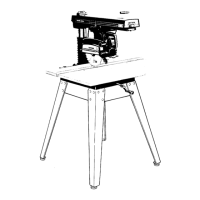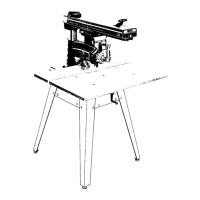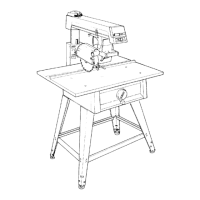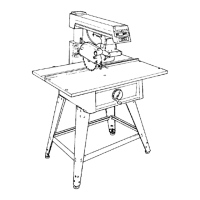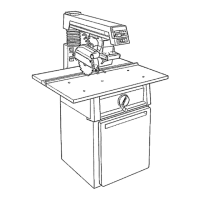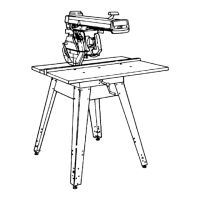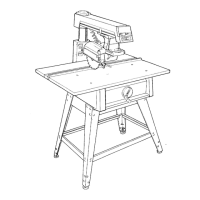additional safety instructions for radial saws
CAUTION: Always disconnect the power cord before
removing the guard, changing the cutting tool, changing the
set-up or making adjustments. Shut off motor before
performing layout work on the saw table.
WARNING: DO NOT CONNECT POWER CORD UNTIL
THE FOLLOWING STEPS HAVE BEEN
SATISFACTORI LY COMPLETED:
I. Assembly and alignment.
II. Examination and operating familiarity with ON-OFF
switch, elevation control, yoke index and lock bevel
index and lock, carriage lock, guard clamp screw,
spreader and antikickback device, and miter index and
lock.
III. Review and understanding of all Safety Instructions and
Operating Procedures thru-out manual,
INSTALLATION
I. Set carriage lock before moving the saw.
2. Bolt the saw to the floor if it tends to slip, walk, or
slide during normal operation.
3. Mount the saw so the table is approximately 39" above
the floor.
4. Mount the saw so the arm slopes slightly downward to
the rear so the carriage will not roll forward due to
gravity.
MINIMIZE ACCIDENT POTENTIAL
Most accidents are caused by FAILURE TO FOLLOW
setup and operating instructions:
(A) GENERAL
-Avoid awkward hand positions, where a sudden slip
could cause a hand to move into a sawblade or other
cutting tool. Never reach in back of or around the
cutting tool with either hand to hold down the
workpiece, or for any other reason; DO NOT place
fingers or hands in the path of the sawblade.
Never saw, dado, mold, or rabbet unless the proper
guard is installed and set up as instructed.
NOTE THE FOLLOWING DANGER LABELS
WHICH APPEAR ON THE FRONT OF THE YOKE
' " 3
AND GUARD: i DANGERI
DANGER: FOR YOUR OWN SAFETY ] TOAVOID
INJURY DO
READ AND UNDERSTAND OWNERS MANUAL BEFORE OPERATING MACHINE. i NOT FEED I
WeA_ SA_TY GOGG,ES s NEVER REACH AAOUNO THE SAwetAOE MATERIAL 1. EePHANDSOUT OFPAtH OFSAWSLAO[ ALLOWrOOt TOSTOPeEFORZAOJUSTPNG
3 KNOV,HOWTOAvo,o K,CK=ACKS _ NOT PE_OAU A_Y O_ERAT'ON _REEHAND INTO
= ,Jsr 'PUSHS,,CK _OaNA.ROWWO_K ! CUTTING i
WARNING: TO AVOID INJURY RETURN CARRIAGE IO IHE FULL REAR _TOOL FROM,
POSITION AFTER EACH CROSSCUT TYPE OF OperATION I ,
[ THIS END
If any part of this radial saw is missing or should
break, bend or fail in any way, or any electrical
component fail to perform properly, shut off power
switch, remove cord from power supply and replace
damaged, missing and/or failed parts before resuming
operation.
- IF YOUR SAW MAKES AN UNFAMILIAR NOISE
OR IF IT VIBRATES EXCESSIVELY CEASE
OPERATING IMMEDIATELY UNTIL THE
SOURCE HAS BEEN LOCATED AND THE
PROBLEM CORRECTED.
-WARNING: DO NOT ALLOW FAMILIARITY
(GAINED FROM FREQUENT USE OF YOUR
SAW) TO BECOME COMMONPLACE. ALWAYS
REMEMBER THAT A CARELESS FRACTION OF
A SECOND IS SUFFICIENT TO INFLICT SEVERE
INJURY.
Before starting work, verify that no play exists
between the column & column support, or in the
carriage, and that arm, yoke, and bevel locks!clamps
are tight.
--A large proportion of saw accidents is caused by use
of the wrong type blade, dull, badly set, improperly
sharpened cutting tools, by gum or resin adhering to
cutting tools, and by sawblade misalignment
out-of-parallel with the fence. Such conditions can
cause the material to stick, jam {stall the saw) or
"KICKBACK" at the operator. NEVER ATTEMPT
TO FREE A STALLED SAW BLADE WITHOUT
FIRST TURNING THE SAW "OFF". If the
sawblade is stalled or jammed, shut saw "OFF",
remove workpiece, and check sawblade squareness to
table surface and to the fence, and check for heel.
Adjust as indicated.
-CAUTION: DO NOT cycle the motor switch "'ON'"
and "OFF" rapidly, as this might cause the sawblade
to loosen. In the event this should ever occur, allow
the saw blade to come to a complete stop and
re-tighten the arbor nut normally, not excessively.
- Do not leave a long board unsupported so the spring
of the board causes it to shift on the table. Provide
proper support for the workpiece, based on its size
and the type of operation to be performed. Hold the
work firmly against the fence.
- Never use a length stop on the free end or edge of the
workpiece whether crosscutting or ripping. Never
hang onto or touch the free end of workpiece when
crosscutting, or a free piece that is cut off while
power is "ON" and/or the saw blade is rotating. In
short, the cut-off piece in any "thru-sawing"
operation must never be confined - it must be
allowed to move laterally.
- Make sure your fingers do not contact the terminals
when installing or removing the plug to or from a live
power source.
Never climb on the saw, or climb near the saw when
power is "'ON". Never leave the saw with power
"ON", or before the cutting toot has come to a
complete stop. Lock the motor switch and put away
the key when leaving the saw.
-Do not use any blade or other cutting tool marked
for an operating speed lower than 3450 RPM. Never
use a cutting tool larger in diameter than the diameter
for which the saw was designed. For greatest safety
and efficiency when ripping, use the maximum
diameter blade for which the saw is designed, since
under these conditions the spreader is nearest the
blade.
- Never turn your saw "ON" before clearing the table
or work surface of all objects (tools, scraps of wood,
etc.) except the workpiece and related feed or
support devices for the operation planned.
- DO NOT perform layout, assembly, or setup work on
the table while the cutting tool is rotating.
- Never perform any operation "FREE HAND". This
term means feeding the sawblade into the workpiece
or feeding the workpiece into the sawblade or other
cutting tool without using the fence or some other
device which prevents rotation or twisting of the
workpiece during the operation. Never "'RIP" in the
crosscut position. Never make a miter cut with the
arm in the 90 ° crosscut position.
Never lower a revolving cutting tool into the table or
a workpiece without first locking the Carriage Lock
Knob. Release the knob only after grasping the Yoke
Handle. Otherwise the cutting tool may grab the
workpiece and be propelled toward you.
-The sawblade, dado, or other cutting tool must be
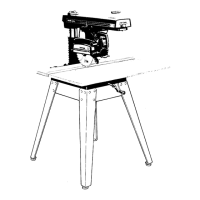
